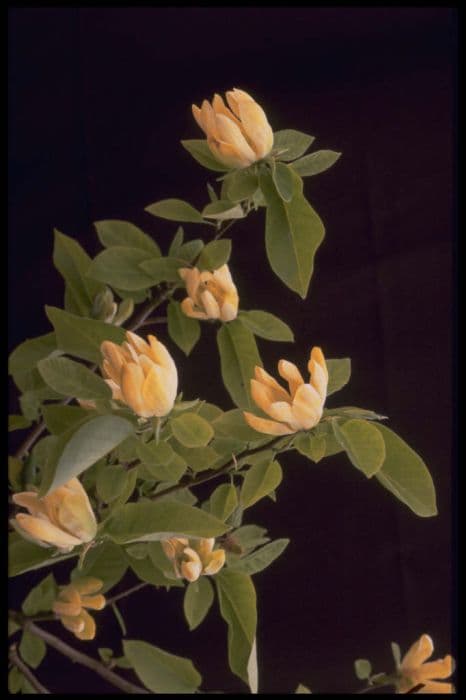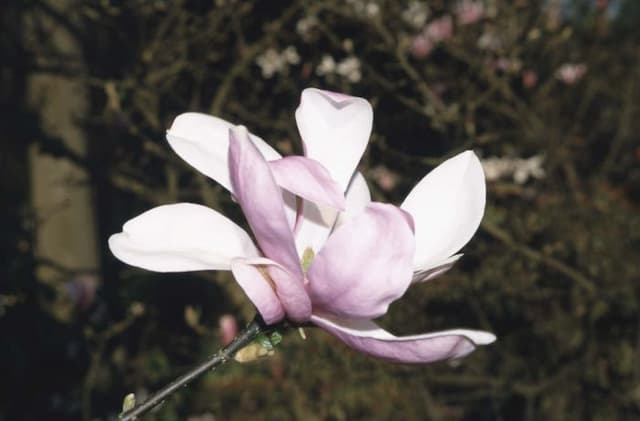Spectrum Magnolia Magnolia 'Spectrum'

ABOUT
Magnolia 'Spectrum' is a stunning ornamental plant known for its large, striking flowers that are sure to catch anyone's attention. These flowers typically showcase a blend of colors, often starting with a deep pink at the base and fading to paler shades near the edges. On some blossoms, you might even find that the pink blends into a creamy white, creating a spectacular spectrum of hues, hence the name 'Spectrum'. Each flower is quite substantial and saucer-shaped, with broad petals that open up from fuzzy buds, exuding an exquisite fragrance that can fill the surrounding air. The leaves of Magnolia 'Spectrum' are equally impressive, with a glossy and leathery texture. They emerge with a coppery-bronze tinge when young, maturing to a deep green that provides a perfect backdrop for the flowers. In the fall, the foliage may turn to warm, golden-brown shades, adding to the plant's seasonal interest. The overall form of Magnolia 'Spectrum' is typically broad and rounded, presenting a lush and healthy appearance. It has a strong branching structure, with its branches covered in smooth, gray bark that provides a nice contrast against the vibrant green of the leaves and the vivid colors of the flowers. This eye-catching plant provides a dramatic and elegant statement in any garden setting, captivating onlookers with its majestic flowers and vibrant foliage.
About this plant
 Names
NamesFamily
Magnoliaceae
Synonyms
Spectrum Magnolia
Common names
Magnolia 'Spectrum'
 Toxicity
ToxicityTo humans
The Magnolia is not commonly associated with any significant toxicity to humans. Most magnolias, including 'Spectrum', are generally considered non-toxic. If a person ingests parts of this plant, they are not expected to experience any severe poisoning symptoms. However, as with any plant material, individual reactions can vary, and some people might experience mild stomach discomfort if large quantities are consumed.
To pets
The Magnolia, including the 'Spectrum' variety, is also not known to be toxic to pets. It is considered to be of low toxicity and ingesting parts of this plant is unlikely to cause any significant or serious symptoms of poisoning in pets. However, as with humans, consumption of large amounts could potentially cause mild gastrointestinal upset, such as vomiting or diarrhea, in some animals.
 Characteristics
CharacteristicsLife cycle
Perennials
Foliage type
Deciduous
Color of leaves
Green
Flower color
Pink
Height
20-30 feet (6-9 meters)
Spread
15-25 feet (4.5-7.6 meters)
Plant type
Tree
Hardiness zones
5-9
Native area
North America
Benefits
 General Benefits
General Benefits- Aesthetic Appeal: Magnolia 'Spectrum' provides ornamental value with its striking large flowers and glossy green leaves.
- Year-Round Interest: It offers visual interest throughout the seasons with blossoms in spring and summer, and sometimes interesting seed pods in autumn.
- Pollinator-Friendly: The flowers attract pollinators like bees, butterflies, and birds, supporting local ecosystems.
- Shade Provision: The tree can provide shade in gardens and parks, making it a practical addition to landscapes.
- Fragrance: Magnolia 'Spectrum' is known for its sweet-smelling flowers, which can enhance the sensory experience of a garden.
- Durability: It is relatively resistant to pests and diseases, reducing the need for chemical treatments.
- Low Maintenance: Requires minimal pruning and care once established, making it suitable for both novice and experienced gardeners.
- Cultural Significance: Magnolias have various cultural meanings and are often considered symbols of purity and nobility.
- Privacy Screen: When planted in groups, Magnolia 'Spectrum' can act as a natural and attractive privacy screen.
 Medical Properties
Medical PropertiesThis plant is not used for medical purposes.
 Air-purifying Qualities
Air-purifying QualitiesThis plant is not specifically known for air purifying qualities.
 Other Uses
Other Uses- Magnolia petals can be used to add a unique and decorative touch to salads, as they are edible and have a spicy flavor.
- The bark of Magnolia trees can be used in the dying process of fabrics, imparting a brownish hue to textiles.
- The tough leaves of the Magnolia can be used in floral arrangements for long-lasting greenery or as an alternative to traditional gift wrap for small presents.
- Wood from Magnolia trees is valued in furniture making for its color and grain, particularly in the creation of fine veneers.
- Dried Magnolia seed pods can be used in craft projects, such as wreath making or as natural decorative elements in potpourri.
- The scent of Magnolia flowers can be infused into oils or candles to provide a natural, calming fragrance to a room.
- Extracted compounds from Magnolia flowers are used in some perfumes and cosmetics for their distinctive and pleasing aroma.
- Pressed Magnolia leaves and flowers can be used in botanical art and herbarium collections due to their striking shapes and sizes.
- Magnolia flowers can be used as a natural fabric freshener when dried and placed in drawers or closets.
- The wood shavings of the Magnolia tree can also be used as mulch in gardens to retain soil moisture and suppress weeds.
Interesting Facts
 Feng Shui
Feng ShuiThe Magnolia is often associated with purity and nobility in Feng Shui. To use this plant, it should ideally be placed in areas that could benefit from these qualities. It could be positioned in the garden to bring balance and to attract positive energy into one’s space.
 Zodiac Sign Compitability
Zodiac Sign CompitabilityThe Magnolia is not used in astrology practice.
 Plant Symbolism
Plant Symbolism- Perseverance and Endurance: The Magnolia tree is known for its ability to survive harsh conditions and has been around since ancient times, which is why it often symbolizes endurance and long life.
- Dignity and Nobility: With its impressive appearance and stately bearing, magnolias are often associated with dignity, nobility, and a sense of pride. They radiate a regal quality that is often compared to high social or spiritual status.
- Femininity and Beauty: Magnolias have large, showy flowers that are often viewed as symbols of feminine beauty, softness, and gentleness. The blossoms represent the magnificence and beauty of a woman.
- Spiritual and Pure: The magnolia tree is frequently featured in religious and spiritual contexts, symbolizing purity, and is often seen in gardens of temples and churches.
- Love of Nature: Magnolias are native to well-preserved natural forests, and their presence can signify a love for nature and the great outdoors.
 Water
WaterThe Magnolia 'Spectrum', commonly known as the Tulip Tree, requires consistent moisture and should be watered deeply, especially during the initial growing seasons to establish an extensive root system. On average, water the tree with about 1.5 gallons per inch of trunk diameter once a week during hot or dry weather. Decrease watering to every two to three weeks during cooler or rainy periods. It is important to avoid overwatering as this can lead to root rot. Ensure the soil has good drainage to prevent water from pooling around the roots.
 Light
LightThe Tulip Tree thrives in full sun to partial shade conditions. It performs best in a location where it receives at least six hours of direct sunlight per day, though it can tolerate some light afternoon shade. Avoid deep shade locations as this will impede its growth and flowering capabilities.
 Temperature
TemperatureThe Tulip Tree can adapt to a wide range of temperatures and is hardy in USDA zones 4 through 9. It can withstand minimum temperatures down to -20 degrees Fahrenheit and is comfortable with the summer heat up to 100 degrees Fahrenheit. The ideal temperature range for this magnolia is between 60 to 75 degrees Fahrenheit for optimal growth and flowering.
 Pruning
PruningThe Tulip Tree benefits from pruning to maintain shape and remove any dead or broken branches, which should be done in late winter or early spring before new growth starts. Prune sparingly, as this magnolia does not require extensive shaping. When pruning, make clean cuts just above a bud or branching point to encourage healthy regrowth. Pruning every 2 to 3 years is generally sufficient unless damage or disease necessitates more frequent attention.
 Cleaning
CleaningAs needed
 Soil
SoilThe best soil mix for Magnolia 'Spectrum' is one that is rich, moist, and well-draining with an acidic to neutral pH, ideally between 5.0 and 7.0. A mix of loamy soil with peat, compost, and a small amount of sand is beneficial for ensuring proper drainage and fertility.
 Repotting
RepottingMagnolia 'Spectrum' trees, once planted in the ground, do not require repotting. However, if grown in a container, they should be repotted every 2 to 4 years, ideally in the spring before new growth begins.
 Humidity & Misting
Humidity & MistingMagnolia 'Spectrum' prefers moderate humidity levels but is quite adaptable. While it doesn't require high humidity, it benefits from being in an environment where the humidity is not consistently low.
 Suitable locations
Suitable locationsIndoor
Place near bright window; ensure pot has drainage.
Outdoor
Full sun to partial shade; protect from harsh elements.
Hardiness zone
5-9 USDA
 Life cycle
Life cycleThe Magnolia 'Spectrum', commonly known as just Spectrum Magnolia, begins its life as a seed, typically sprouting in spring under suitable conditions of warmth and moisture. The seedling goes through a juvenile phase, developing a root system and foliage as it matures into a young plant. Over several years, the young tree will experience vegetative growth; it develops woody stems, branches, and broad, dark green leaves. As the tree reaches maturity, it begins its reproductive stage, producing large, fragrant flowers ranging from pink to purple, which then give way to cone-like fruit containing the seeds. The flowering season is primarily in early to late spring, but older trees may have sporadic blossoms at other times. After the peak reproductive years, the tree enters a phase of senescence, with its growth slowing down, and eventually dies, completing its life cycle.
 Propogation
PropogationPropogation time
Spring-Early Summer
Propogation: The most popular method of propagating Magnolia 'Spectrum', a hybrid variety of magnolia, is through semi-hardwood cuttings. This process is typically done in late summer, when new growth has begun to mature and harden slightly. Choose a healthy branch and make a cut to obtain a segment about 4 to 6 inches long (10 to 15 centimeters), just below a leaf node. The lower leaves are removed, and the cut end may be treated with rooting hormone to encourage root development. The cutting is then placed in a well-draining rooting medium such as a mix of peat and perlite, ensuring the node is buried where leaves were removed. The environment should be kept humid, which can be accomplished by covering the cutting with a plastic bag or placing it in a greenhouse, and it should be kept out of direct sunlight to avoid overheating. Roots typically develop in a few weeks, after which the new magnolia plant can be gradually acclimated to less humid conditions and eventually planted in its final location.



![Magnolia [Black Tulip]](/_next/image?url=https%3A%2F%2Fplants-admin.emdemapps.com%2Fimages%2Fplants%2F%2Fimages%2F604b590290fc7.png&w=640&q=75)





